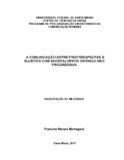| dc.creator | Bortagarai, Francine Manara | |
| dc.date.accessioned | 2011-09-27 | |
| dc.date.available | 2011-09-27 | |
| dc.date.issued | 2011-03-04 | |
| dc.identifier.citation | Bortagari, Francine Manara. Communication between physiotherapists and
subjects with chronic non-progressive
encephalopathy. 2011. 112 f. Dissertação (Mestrado em Fonoaudiologia) - Universidade Federal de Santa Maria, Santa Maria, 2011. | por |
| dc.identifier.uri | http://repositorio.ufsm.br/handle/1/6498 | |
| dc.description.abstract | This work presents an investigation of the way physiotherapists perform their communication with subjects with chronic non-progressive encephalopathy (CNPE)
having restricted or absent speech. For this purpose, we interviewed twelve physiotherapists about non-verbal communication and then we interviewed the five
physiotherapists who knew and used the alternative and augmentative communication (AAC) in therapy about the use of this resource. After the initial reading of the narratives, we noticed that all the physiotherapists consider non-verbal communication important and perform it, mainly through reading facial and body expressions. Concerning the use of AAC, the five professionals of the sample emphasized the importance of this resource, although only one of them makes use of it routinely. We conclude that the physiotherapists strive to invest in non-verbal communication and/or AAC with CNPE subjects who present restricted or absent speech and that such an investment improves the hospitalization outcomes and the
interaction between the subjects and the professionals who treat them. However, the theoretical and practical learning of non-verbal communication and ACC seems
flawed and inadequate in physiotherapy undergraduate course. This fact can be considered one of the causes of the poor use of non-verbal communication as well
as one of the causes of the lack of knowledge or of the non-routine use of AAC in therapy. The results suggest the need to overcome the purely biomedical model in
the formation of the physiotherapist and to adopt some training that seeks to humanize and promote quality in physical therapy services. | eng |
| dc.format | application/pdf | por |
| dc.language | por | por |
| dc.publisher | Universidade Federal de Santa Maria | por |
| dc.rights | Acesso Aberto | por |
| dc.subject | Encefalopatia crônica não progressiva | por |
| dc.subject | Fisioterapia | por |
| dc.subject | Comunicação não verbal | por |
| dc.subject | Comunicação aumentativa alternativa | por |
| dc.subject | Humanização | por |
| dc.subject | Chronic non-progressive encephalopathy | eng |
| dc.subject | Physiotherapy | eng |
| dc.subject | Non-verbal communication | eng |
| dc.subject | Alternative and augmentative communication | eng |
| dc.subject | Humanization | eng |
| dc.title | A comunicação entre fisioterapeutas e sujeitos com encefalopatia crônica não progressiva | por |
| dc.title.alternative | Communication between physiotherapists and subjects with chronic non-progressive
encephalopathy | eng |
| dc.type | Dissertação | por |
| dc.description.resumo | Este trabalho apresenta uma investigação sobre a forma de comunicação que o fisioterapeuta efetua durante a sessão com o sujeito com Encefalopatia Crônica Não Progressiva (ECNP) com oralidade restrita ou ausente. Para tal meta, foram
realizadas entrevistas com doze fisioterapeutas sobre a comunicação não verbal e, a seguir, sobre o uso da Comunicação Aumentativa Alternativa (CAA) na terapia com
cinco fisioterapeutas que conheciam e utilizaram esse recurso. Após a leitura inicial da coletânea das narrativas, verificou-se que todos os fisioterapeutas consideram
importante e realizam a comunicação não verbal, principalmente por meio da leitura de expressões corporais e faciais. Quanto ao uso da CAA, os cinco fisioterapeutas
do grupo amostral ressaltaram a importância desse recurso, embora somente um desses o utilize rotineiramente. Conclui-se que os fisioterapeutas procuram investir em uma comunicação não verbal e/ou CAA com o sujeito com ECNP que apresenta oralização restrita ou ausente e que tal investimento produz melhoras na interação e no vínculo com o sujeito em tratamento. Todavia, o aprendizado teórico e prático, tanto da comunicação não verbal quanto da CAA, apresenta-se falho e insuficiente na graduação de Fisioterapia. Esse fato pode ser considerado como uma das
causas do investimento precário na comunicação não verbal, assim como do desconhecimento ou do uso não rotineiro da CAA na terapia. Os resultados sugerem a necessidade de ultrapassar o modelo exclusivamente biomédico na formação do fisioterapeuta e de adotar uma formação que busque a humanização e a promoção de qualidade no atendimento fisioterápico. | por |
| dc.contributor.advisor1 | Souza, Ana Paula Ramos de | |
| dc.contributor.advisor1Lattes | http://lattes.cnpq.br/7859963389320763 | por |
| dc.contributor.referee1 | Ressel, Lúcia Beatriz | |
| dc.contributor.referee1Lattes | http://lattes.cnpq.br/8115118488275159 | por |
| dc.contributor.referee2 | Kessler, Themis Maria | |
| dc.contributor.referee2Lattes | http://lattes.cnpq.br/2895849023580274 | por |
| dc.creator.Lattes | http://lattes.cnpq.br/9006898344216198 | por |
| dc.publisher.country | BR | por |
| dc.publisher.department | Fonoaudiologia | por |
| dc.publisher.initials | UFSM | por |
| dc.publisher.program | Programa de Pós-Graduação em Distúrbios da Comunicação Humana | por |
| dc.subject.cnpq | CNPQ::CIENCIAS DA SAUDE::FONOAUDIOLOGIA | por |


